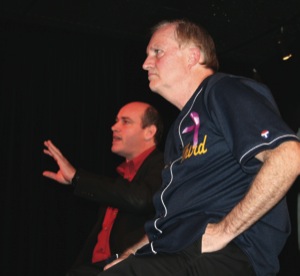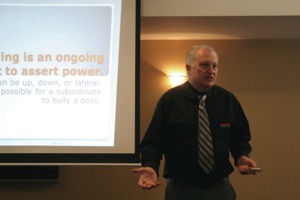
October is anti-bullying month and like “Black History Month” or “Mother’s Day,” it’s something that should be observed all 12 months and 365 days a year. But given the sound-bite attention span of the public, having a reason to issue press releases and hold special events is better than forgetting entirely that there are still issues that need to be addressed.
The bullying crisis coincidentally started making the news just after my novel Rounding Third was published and because my book deals powerfully with that topic, I began getting requests to write and speak about the problem all over the country. In addressing groups at high schools, colleges, libraries, community centers and corporations, invariably the question comes up, “Is bullying worse or better than it used to be?” And I answer, “Yes.”
It’s both better and worse.
Carrie Goldman wrote her book, Bullied: what every parent, teacher and kid needs to know about ending the cycle of fear after her daughter’s experience of being bullied became a national news story. Goldman and I participated in an anti-bullying conference at USD put on by the Anti-Defamation League. In Goldman’s research she found, “Many schools, but not all, are taking bullying more seriously. While there is no federal law against bullying, 49 of the 50 states do have laws against bullying. Just because the laws exist, however, does not mean that all schools hold their students and faculty to the legal standards.”
While most schools, and society as a whole, are taking bullying much more seriously, there is also another dimension to bullying that didn’t even exist when she and I were in school: cyberbullying. Now when a student comes home, instead of finding a safe haven, targets of bullying can’t turn on an electronic device without encountering grief. Goldman said, “Conservatively, about 20-25 percent of kids are cyberbullied, and about 15 percent of kids admit to cyberbullying others. But when you read the newspaper, it feels like the percentages are higher, especially when the stories are linked with devastating suicides. And the fact is, these percentages still translate to hundreds of thousands of kids suffering from the effects of being bullied every year.”
I have participated on anti-bullying programs with Kevin Beiser, who is now president of the San Diego Unified School Board. He helped craft a district-wide policy that is one of the most progressive in the country. Beiser explains, “The policy included both expectations for what behavior would not be asked accepted or tolerated in our schools establishing a cultural expectation of inclusion and tolerance in our schools.”
What sets this policy apart Beiser says is, “A large component of the anti-bullying policy is not so much punitive as it is preventative and helping students to be more aware of their actions and what they can do to prevent or intervene and report bullying. There’s also a very large component of the policy which involves helping children to learn from their mistakes to help improve and modify behavior taking these opportunities to make it a teachable moment.”
Too often LGBTQ youth are the targets, or at least perceived sexual orientation is the focus: being called “gay” is the default insult.

Vincent Pompeii, director of the Youth Well-Being Project and Time to Thrive Conference chair for the HRC, says, “The deck continues to be stacked against young people growing up LGBTQ in America. The impact of family rejection, bullying and daily concern for safety weighs heavily on our youth. In 2012 HRC released a groundbreaking report titled, Growing Up LGBT in America. Findings revealed that LGBT youth are more than two times as likely to be verbally harassed in school, 33 percent say their family is not accepting of LGBT people and 63 percent say they will have to move to another part of the country just to feel safe.”
Goldman agrees, “Many LGBTQ kids do not have a good support system at home, unlike some of the other targets of bullying, and this lack of support at home contributes to increased feelings of emotional distress. LGBTQ kids need their friends and families to give them more love and acceptance.”
As more students come out at younger ages, they’re less afraid to report it if they are bullied for their sexual orientation.
Trish Hatch, the executive director of the Center for Excellence in School Counseling and Leadership at SDSU said that when she works with school counselors all over the country, “We often see referrals (for bullying) go up, but are they really going up or are people just more aware of it?” She adds that proper training for school counselors is essential because they need to provide assistance to the bully as well as the victim. There is often a reason the bullies are behaving the way they are and if a counselor can get to the root of the issue, they can prevent the next incident. “School counselors,” she said, “are integral to providing support, prevention and intervention.”
Whether the problem is really getting worse, or people are just more aware of it and therefore more likely to report and respond to it, Catherine Mattice said it’s important to stop the cycle of bullying with young people because, “People learn to communicate and interact when they’re younger. If you are a target, you learn to be a victim. If you’re a bully, you learn it works for you.
It affects you your entire life.” Mattice is president of Civility Partners and author of a book about workplace bullying, Back Off! She and I have worked together on several anti-bullying projects.
Mattice said, “Career Builder did a large study and found that 35 percent of people feel bullied at work. It’s a huge number. Other studies have had similar results.” She added that school bullying and workplace bullying “… are equally bad, but for different reasons. As a child you’re still learning, but as an adult what you do for a living is an important part of our lives. It damages your core at either end. 11 percent of people bullied at work contemplate or commit suicide.”
When Mattice first started speaking out about workplace bullying not many people thought it was a real problem, but now she says, “People are taking it seriously. Media attention on school bullying has helped this. I’m asked to speak constantly.”

California recently became the third state to pass a law about workplace bullying, and while it is better than the other two, Mattice said it doesn’t go far enough to protect workers. But if a worker is bullied for being LGBT that constitutes harassment, which is covered by other laws.
The theme of the presentations I give to schools, corporations and other groups is “Accept and respect: yourself and others.” If you accept that you are gay, being called that has no power. If you respect yourself, the opinions of others (good or bad) have little impact on your self-worth. That respect and acceptance should extend to others, and not just where bullying or kids or sexual orientation is concerned. Is it really necessary to post that snarky comment on Facebook about someone’s hair or Tweet about what they wore to the gym? There is a quote that has been attributed to many people, usually to Philo of Alexandria, but even if it originated with my great-aunt from whom I first heard it, the message is still valid: “Be kind for everyone you meet is fighting a great battle.”
For LGBTQ kids, that is often an internal battle they’re afraid to share with anyone and a kind word instead of an insult could make all the difference in the world. We can each do our part to lessen the effects of bullying at any age.
Freelance writer Walter G. Meyer is the author of Rounding Third and is a nationally-recognized anti-bullying champion. Waltergmeyer.com











